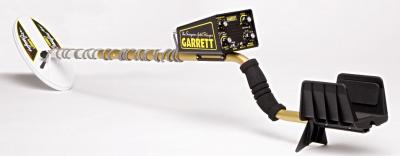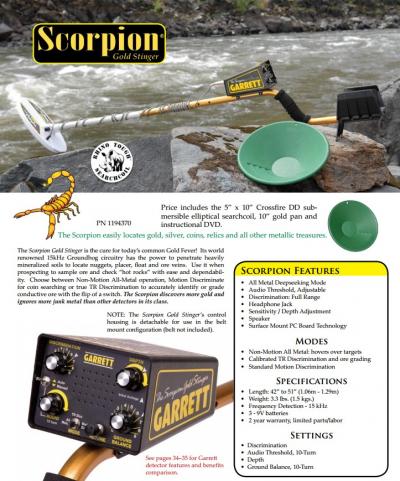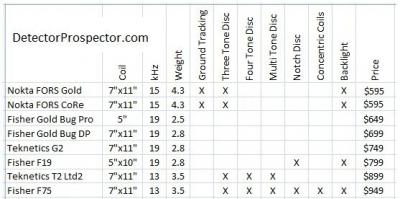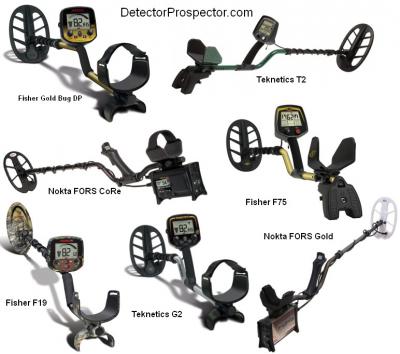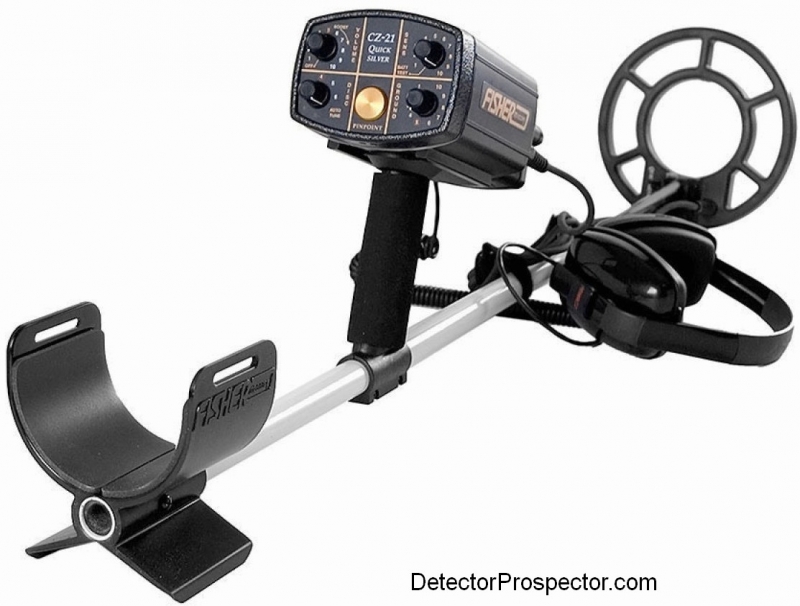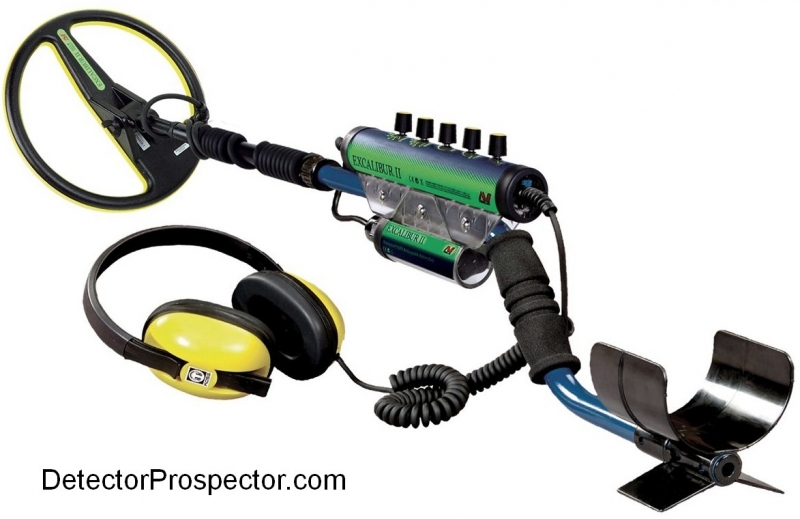-
Posts
19,755 -
Joined
Content Type
Forums
Detector Prospector Home
Detector Database
Downloads
Everything posted by Steve Herschbach
-
Excellent - smart move on Rob's part!
-

Makro Racer Pricing
Steve Herschbach replied to Nokta Detectors's topic in Nokta / Makro Metal Detectors
No doubt you are right Ray. Funny thing is IF there had been a 5.5" x 10" DD coil for the Fors Gold and IF it was what was being used instead then all the noise would have been about that coil and everyone would be excited to be getting it. The 5.5" x 10" DD in my opinion is going to prove the be the best all around coil for the detector and is the reason I hope it comes stock on the Gold Racer. I am in full agreement about there needing to be a small coil for the Racer. The difference is I never doubted for a second it would happen. I am still recommending that the prospectors wait and see what the Gold Racer offers. -
If you can get an ATX within your budget and do not look back you will have made a good choice. The mistake most people make is in not trusting their judgment, and then when quick results do not come, sell the first choice. Get a good unit like the ATX or FORS Gold and apply yourself to it and you can do as well as anyone. When you say the Gold Bug 2 is complicated and uncomfortable though that is a warning bell. Many long time miners can't stand metal detecting. It really is not nugget detecting. It is nail and bullet detecting, and sometimes you find a nugget. Beware of videos. They are very, very easy to manipulate, and not always intentionally by any means. If I think detector A is great and want to make a video showing you how great detector A is, well, you can predict the end result.
-
There are very many choices and they are all very, very good. Think hard about what it is you want to do exactly with the detector. Not hoped for maybe someday stuff but the actual day in and day out use of the detector. Personally I think the sweet spot for beginners is around $700 with lighter weight simpler machines starting out. I highly recommend you look over my just updated Nugget Detector Review
-

Makro Racer Pricing
Steve Herschbach replied to Nokta Detectors's topic in Nokta / Makro Metal Detectors
Lots of complaining on the other forums about the current lack of 4.7" x 5.2" coil. The Nokta coils will not work on the Makro. I do think that the 5" x 10" is a more useful size but people are fascinated by the little coil, and with good reason. It is a great little sniper coil. Might be that regular Racer should come with 11" x 7" coil and Pro Pack also includes 5.2" x 4.7" coil Then make Gold Racer stock with 10" x 5.5" coil and Pro Pack also includes 5.2" x 4.7" coil. No matter what you do somebody will complain though! -
The Gold Bug Pro or even the basic Gold Bug are the current bang-for-the-buck though the new Gold Racer may shake that up a bit. It is annoying that Fisher does not offer the Gold Bug Pro standard with the 5" x 10" DD, which really is the only reason from a prospecting standpoint to look at the F19. If you get the Bug then get that coil you are close to F19 pricing. Why do they not offer the Gold Bug with the one coil it should really come with? Because they will sell you the machine and then the coil as an add on sale. I hate being manipulated like that. Just drop the Gold Bug Pro with 5" coil and drop the Gold Bug DP which is just the Pro with 11" coil and come out with the Gold Bug Pro with 5" x 10" DD for MSRP $699 or $649 out the door. If we want the small coil or the larger coil we can get them, but most people would be best served with the 5" x 10" DD.
- 13 replies
-
- fisher detector
- fisher gold bug
-
(and 1 more)
Tagged with:
-
RIP Gold Stinger! Garrett quietly discontinued the Scorpion Gold Stinger last year. It is no longer on their website or in their new catalog and generally unavailable for purchase though a few no doubt remain on dealer shelves. The Stinger was introduced in 1990 and so enjoyed a 25 year run. Pretty amazing really for such a lackluster machine. The Stinger was basically an old 15 kHz Groundhog stuffed in an updated box. The box I loved to hate, as it featured without a doubt the worst battery replacement system on the market. It also suffered from a dearth of accessory coils. Once the AT Gold was released it was inevitable that the Stinger would finally go its way and the day has finally come. About time is all I can say.
-

Makro Racer Pricing
Steve Herschbach replied to Nokta Detectors's topic in Nokta / Makro Metal Detectors
I am glad you are back home safely and hope you found time for more than just work while in the US. Since that is MSRP I guess the question is whether discounts will apply and what they will be. Does Makro enforce a Minimum Advertised Price (MAP)? I like the new 5.5" x 10" DD option. Even at MSRP that is aggressive pricing for the features offered. I can't think of any detector right now offering both manual ground balance and ground tracking at that price point. Ultimately due to the nature of this forum I think what people are going to be most interested in is the Gold Racer. I know that is the one I am hoping becomes my number one VLF prospecting machine. The new 5.5" x 10" DD is a step in the right direction there. That needs to be the stock coil on the Gold Racer. -
As I said in the posts "Other detectors not being discussed here does not reflect on them in any way other than that they are not as similar as all these". My posts on this forum are a bit different than what you may see on other forums in that all they are is reflections of whatever it is that I am personally studying at the time. I am not trying to recommend anything or make decisions for anyone but myself. My own personal interests and bias regarding what make a good detector for me and my purposes leads me to be looking at different detectors from time to time. The best part is I can say anything I want any way I want and nobody is going to censor me! So as I am studying up and considering things I find myself refreshing information I used to know and forgot or just plain never knew. I spend a lot of time on this stuff and I figure if it can benefit somebody else, why not? I do find writing it all up helps me sort things out in my own head also. Sometimes just putting the post together leads me off on a tangent I had not considered before. Putting that little chart together was fun and reminded me again of what makes a T2 different than a F75. In no way however am I attempting some kind of far reaching overview of all detectors for nugget detecting. The closest you are going to get to that is my Nugget Detector Guide which I update constantly. The MXT is just as good as it ever was. Nothing has changed there. What has changed is me. The direction I am heading is lighter weight detectors. The PI manufacturers hate me and are making everything as heavy as possible as part of a concerted effort to frustrate me. No joy in PI land. But in VLF detectors I am not willing any longer to look favorably on dry land detectors weighing over 4 lbs. The 4.3 lb Nokta unit I currently have I am hoping will end up being replaced in my collection by a lighter weight Racer model that is every bit as capable. It is the 21st century and detectors are pretty well maxed for performance. The low hanging fruit is weight and balance. I am hoping if we can't get better performance at the very least we should get what performance we have packed into lighter weight, better balanced detectors. White's headed the right way with the MX5 at a well balanced 3.9 lbs. but lost me when they locked the unit in ground tracking mode. Bummer. Hopefully there will be an MX6 with ground grab in the future. Even 3.9 lbs is starting to look heavy these days though. Three pounds or under is the new goal for VLF detectors. Five pounds and under for PI detectors, which are more limited by coil weights. The key thing about my posts, and THIS IS VERY IMPORTANT - I am just putting out information. I am not trying to sway anyone on anything and I do not want people doing something just because I am doing it. I talk about my particular uses and preferences merely to help you also think about your own. What do you need a detector for? What features are important to you? I hope a key take away is that VLF technology is extremely mature and everyone makes a really good unit at any particular price point you want to choose. I kid you not, I could buy Garrett AT Pro and still do everything I want to do. I could find gold nuggets, coins, and jewelry with it above and under water, all for under $600. I doubt it would seriously slow me down all that much. I would just change my strategy a bit as far as what areas I might hunt and what ones I might avoid. Am I exaggerating a bit here? Of course, but it is not as far from the truth as people might think. Anyway, it is all very much without general agenda or direction, just me riffing randomly on whatever has my interest at the moment. Mainly I want it to help somebody out with their own decisions. If just a few people mine a few nuggets of helpful information here then it is worthwhile for me.
- 13 replies
-
- fisher detector
- fisher gold bug
-
(and 1 more)
Tagged with:
-
Actually I would say you called it right. A lot of people would call that a picker. Bigger than a flake for sure - you can pick it out of a sluice box. Where something gets called a nugget is purely personal opinion. You could call that a gold nugget and many people would agree. Many others would say it is too small. There is no exact rule. Nice no matter what you call it!
-
OK, lets narrow this down a bit. Again, I put all these detectors together because they are so very much alike. They are all made by First Texas, except the two Nokta units. Other detectors not being discussed here does not reflect on them in any way other than that they are not as similar as all these. All the detectors on this list feature ground grab, manual ground balance, full time visual display indicator (VDI) number, all metal mode plus mono and dual tone disc modes. These are standard features on most VLF detectors used for general purposes to include prospecting. The table displays features that are not common to all the units. The prices are discounted prices as found on the internet on 7/25/2015 and are subject to change at later dates. Ground Grab - The ability to ground balance a unit by pushing a button, raising and lowering it over the ground a couple times, and releasing button. Sometimes referred to as push button ground balance or automatic ground balance. Manual Ground Balance - The ability to manually adjust the ground balance setting up or down, in conjunction with or separately from the Ground Grab function. Ground Tracking - The detector continuously monitors and automatically adjusts in an attempt to keep an optimum ground balance setting at all times. This can be a very valuable function on extremely variable ground and large cobble piles. It can impede the detection of very weak signals and so needs to have the ability to be disabled. Some detectors are always set to ground track - this is not desirable and does not include any detector on this list. Full Time Visual Display Indicator (VDI) Number - The unit has a LCD display that puts a number on screen whenever the detector thinks it has enough information to give a probable target id. This function is available in all modes on all these detectors, including the all metal mode. Many detectors disable this function while in all metal mode. All Metal Mode - This is a true unfiltered threshold based all metal mode. Beware of detectors that have a discrimination mode set to accept all items and calling that an all metal mode. That is more properly called a "zero discriminate mode" because it is still a filtered discrimination mode with reduced sensitivity and depth of detection. Almost any detector with a true threshold based all metal mode will also have a threshold control and a ground balance control. If these functions are lacking be cautious. Mono Discriminate Mode - The ability to use a discrimination control such that all items below a certain setting are rejected or ignored. All items above the setting give an audio indication. This may employ VCO (Voltage Controlled Oscillator) audio which increases the pitch and volume of the audio as the target strength increases. Dual Tone Discriminate Mode - Ferrous (steel and iron) items produce a low tone, non-ferrous items produce a higher tone. The point where the tone shift occurs may or may not be adjustable. Three Tone Discriminate Mode - A third tone is produced by high conductive targets that usually identify most US coinage, with the possible exception of US nickels, which are a medium conductive target. A typical three tone scheme has a low tone for ferrous targets, a medium tone for medium conductive target that includes most gold items (but also lead and aluminum) and US nickels, and a high tone for clad, copper, and silver coins. However, some detectors like the Fisher F75 offer a modified version that shifts nickels into the high tone range. Four Tone Discriminate Mode - The medium tone in the three tone scheme above is split in half with a low mid tone and a high mid tone. The high mid tone range usually includes zinc pennies, aluminum screw caps and square tabs, but also can include many older coins like Indian Head pennies, Flying Eagle Cents, Three Cent silvers, and $5 gold coins plus very deep and on edge coins. The low mid tone range is the "sweet spot" for valuable gold and platinum jewelry. Multi Tone Disc - This ties the tones produced to the target id numbers. The higher the number, the higher the tone. It can produce information overload for new operators but can be a valuable tool for professionals working in modern trash. Notch Disc - This allows a certain VDI range to be selectively rejected. For instance, if at a ballpark a certain type of aluminum pull tab was found to be very prevalent, the signal from just that pull tab could be rejected while everything else was accepted. In a nugget hunting scenario, if an area was littered with thousands of .22 shell casings, the signal from just the casings could be eliminated. However, in either case a gold item that read identical to the pull tab or .22 shells casing would also be lost. This might be an acceptable trade, especially when nugget hunting if you know the general nature of the gold in the area. Concentric Coils - There has been a huge movement towards the use of DD coils these days and a sort of mythology has sprung up that they are better in all cases. However, one only need look to the Fisher Gold Bug 2, which only employs concentric coils, to know this is not true. Concentric coils are like mono coils on a PI detector and when conditions allow (milder ground) will go deeper than the identical size DD coil. The sharp edge knife blade depiction of a DD coil search field is also a marketing myth. If you do not believe that, simply set your detector up and run a dime around under the coil to get an idea of where and how it responds. A round concentric coil produces a field like a soccer ball cut in half. A DD coil produces a field more like a football cut of half lengthwise. DD coils handle bad ground better but concentric coils tend to have better ability to separate ferrous and non-ferrous items. DD coils have great difficulty with bottle caps where concentric coils tend to easily identify them as ferrous targets. The ability to employ concentric coils is getting rare these days but can be a secret weapon in some circumstances. Backlight - The ability to light the LCD screen up for low light conditions.
- 13 replies
-
- fisher detector
- fisher gold bug
-
(and 1 more)
Tagged with:
-
Hi Bear, Welcome to the forum! Anything I can do to help, just holler.
-
I have now put enough time on all these units to at least reach a basic conclusion in my own mind. And that is that they are far more alike than different. Trying to get clear differences to appear in actual field use in highly mineralized ground is a true exercise in hair splitting. A couple detectors that can be added to the title list are the Teknetics T2 and G2 models. First Texas owns Fisher and Teknetics. The T2 is the predecessor of the F75. They are not exactly the same detector (they do not share coils) but almost identical in performance. The G2 really is just a Gold Bug Pro in different clothes. 13 kHz - Fisher F75 and Teknetics T2 15 kHz - Nokta FORS Gold and FORS CoRe 19 kHz - Fisher Gold Bug Pro, F19, Teknetics G2 In actual use the frequency just about says it all. The lower frequency F75 and T2 are just a tad less sensitive to very small low conductors, like a small gold nugget. The 15 kHz FORS is almost an exact match to the Gold Bug Pro/F19/G2 for sensitivity to small low conductors and so despite the bigger frequency gap I would say the FORS models come closer to the higher 19 kHz models than the lower 13 kHz models. I have to say it all just boils very much down to the feature list, and again, they line up pretty well. The less expensive Gold Bug Pro and G2 have a more limited feature set than the F19. The F75 has the most options for tones and settings at the highest price on the list. The Nokta units at their new lower price are a real good value. For me when it came down to actual performance the Gold Bug Pro/ F19 were so close to the FORS models I let the two Fishers go and kept the Nokta. Basically just to get the automatic ground tracking which can be very useful in variable ground but also the three tone option, which is nice for coin detecting. I also like the way the Nokta units balance better with larger coils. All I can tell anyone at this point if you want a detector to use for nugget detecting and also for other purposes, the Gold Bug Pro/F19/G2/FORS Gold and FORS CoRe are so close in actual field use that it will all come down to the operator and ground variations. I think the machines are a toss up from a performance perspective and so just line up the feature list and go with whatever floats your boat. I think for sheer value at this time the Nokta FORS models are tough to beat. The T2 and F75 give up a slight edge on small low conductors. What this means is that all the previously mentioned models are better for smaller gold nuggets. The trade off is the T2 and F75 are better all around detectors for general purpose use, gaining in coin and other high end conductors some slight advantage simply because the machines are not quite so sparky on tiny non-ferrous trash. In moderate to low mineral ground conditions the T2 and F75 have a clear depth advantage on high conductive coins but in very mineralized ground the advantage is nearly non-existent. In my case at least I feel like there is a 90% overlap between my latest version F75 and the two FORS models. If I head out the door right this second to go hunt coins I am more likely to grab the F75 as I like the extra tone schemes. There is the 3H mode that gives a high tone beep on all normal coins but also takes US nickels, which usually reads as a mid tone, and puts it up in the high tone range also. This is a great cherry picking mode. The standard 4 tone mode is great for cherry picking jewelry digging the low mid tones. I like the big screen and the backlight, etc. So I am also keeping my F75. But if I was heading out the door chasing gold nuggets right now in a really trashy location and not wanting to use a PI, I would grab the FORS instead. It pulls low conductors like small gold nuggets out of the ground better than the F75. Not by a huge margin, but enough to matter to me. And that is where it will stay for now. I am waiting to get my hands on the new Makro Racer models this summer, and using the F75 and FORS plus Racer units all summer. Then proceeding to phase two of the weeding process. I am trying very hard to get my detector collection down to just a couple PI detectors and a couple VLF detectors. It is down to that stage of the game however where it just needs a lot more in field use to let things sort out for me. What I can leave you with for sure right now however is that these are all very good detectors that are ridiculously close in performance. You really just can't go wrong with any of them. Mid frequency VLF technology has matured to the point where it is almost impossible for anyone to really stand out from a performance standpoint. Nearly all the performance debates I see on the internet about these models boils down to differences in ground mineralization more than the machines themselves. Just find one that feels right on your arm and sounds good to your ear and get to work! This is very much a work in progress and so as I get a chance to use the large coils or hunt under different ground conditions if I come up with anything if interest I will add it here. There is a related thread on VDI numbers and tones at https://www.detectorprospector.com/forums/topic/526-fors-gold-f75-v3i-tone-and-vdi-tidbits/. For detailed information on each model plus the latest prices visit Steve's Guide to Gold Nugget Detectors
- 13 replies
-
- fisher detector
- fisher gold bug
-
(and 1 more)
Tagged with:
-

Finds Of A Lifetime! Silver And Gold!
Steve Herschbach replied to Ron (CA)'s topic in Metal Detecting For Coins & Relics
There are few highs as intense as seeing big gold come out of the ground. I have done the nugget thing but am still waiting to see that gold coin pop out of the ground. That video is just great on so many levels, not least in being motivational. Just time to get out and do it. Thanks for having the presence of mind to do these videos. I keep thinking about it but once I am on a hunt I get so intent on what I am doing I just have not got around to it yet. Chris and I shot a lot of video with JP while in Australia and it is a lot of work not only to record but then to edit. So again, thanks. I really enjoyed that. And congratulations to Mark and Andrew!- 19 replies
-
- coin detecting
- amazing finds
-
(and 1 more)
Tagged with:
-
T2 is the direct predecessor of the F75 which I have used extensively. The T2 costs a bit less and has been extremely popular in Africa as a gold hunter. Anything I have written about the F75 as regards gold would apply to the T2. http://www.detectorprospector.com/gold-prospecting-equipment/fisher-f75-ltd2-metal-detector.htm The part about detects targets deeper than any other detectors is of course hype.
-

White's MXT vs White's V3i
Steve Herschbach replied to Sunriseboy's topic in White's Metal Detectors
Hi Robin, It was a great question and so I like to take the time to try and craft a good answer that will help not just you but others. That is what is great about forums, and why I prefer people not email or PM me eith questions. Get it out on the forum where due to the magic of Google many can benefit from the discussion. So thank you! -

Detector With Good Discrimination
Steve Herschbach replied to AndreyW's topic in Metal Detector Advice & Comparisons
I would definitely invest in the 18.75 kHz elliptical for prospecting. -

New Makro Racer Coming In February
Steve Herschbach replied to Nokta Detectors's topic in Nokta / Makro Metal Detectors
Racer is 14 kHz. They have not announced what the Gold Racer will run at. -

New Makro Racer Coming In February
Steve Herschbach replied to Nokta Detectors's topic in Nokta / Makro Metal Detectors
I have been informed I will be receiving one of the first available Makro Racer units. I am more impressed with the Nokta FORS models the more I use them (yes, I am out detecting in January - eat your hearts out Alaskans!) and I am quite anxious to see what the Makro Racer delivers. So stay tuned! -
This is going to sound really funny coming from somebody who discusses and obsesses so much over metal detectors. In my case at least the metal detectors themselves do not really have a whole lot to do with it. Or at the most only in a very broad sense. What I need by way of a detector is one broadly applicable to the task at hand. In other words, if I am salt water beach detecting, I need a detector that works well on salt water beaches. So I would be looking at a Fisher CZ-21, Garrett Sea Hunter, Garrett Infinium, Garrett ATX, Minelab Excalibur, Minelab CTX 3030, Tesoro Sand Shark, White's Beachunter ID, or White's Surf PI. In other words, a waterproof multi frequency or pulse induction detector. Which one of all the above I grab will not matter all that much. What matters is: A. Location, location, location. Have to be in a good spot to find whatever it is I am looking for. Lacking that all else is a waste of time. B. Know whatever detector I do choose to use and have the ability to use it properly. C. Hard work and patience. Though the work need not be hard or even work, since I enjoy doing what I do. The detectors vary somewhat in performance but not so much that I cannot offset whatever they lack by working harder than the other person. A just barely ok detector worked well and patiently on good ground will always trump the best detector sitting in a closet. I honestly am not some kind of tuning expert. I never did really learn what everything on my GPX 5000 did. I just get a detector running well enough and then get to someplace decent and put in the hours. Finally, as a friend says - it is better to be lucky than be good!
-

Allan Trees Gold Rocker Box
Steve Herschbach replied to tvanwho's topic in Gold Panning, Sluicing, Dredging, Drywashing, Etc
Hi Tom, Yes, I got a Gold Grabbin Rocker from what used to be the Gold Dredge Builders Warehouse but which now looks to be named Gold Grabber Manufacturing LLC. In either case it is Alan Trees. Here is the page on the Gold Grabbin Rocker There also is a new Mini Rocker Alan Trees Gold Grabbin Rocker Here is a previous thread on the rocker at http://www.detectorprospector.com/forum/topic/93-gold-grabbin-rocker/ that includes a video. I bought it brand new, hauled it around Alaska all summer two years ago and never used it, and sold it unused before I left Alaska. Lesson being Steve would rather metal detector than shovel dirt! I think it looked to be a great product and if I wanted a rocker I would buy one all over again. -
Excalibur and CZ are the two best most well regarded multi frequency salt water detectors you can buy. You can read for hours pages comparing both and the result will be they both are good. Again, a style difference. The Excalibur has a fluty multi tone response. CZ a more distinct three tone system. Excalibur an odd and unique physical design not noted for being particularly robust. More maintenance than the more bullet proof CZ. The CZ has a more traditional control box easily hip or chest mounted. The CZ also just had a huge price increase. My best advice is download and read owners manual for both to help decide. Fisher CZ-21 Owners Manual Minelab Excalibur II Owners Manual Fisher CZ-21 CZ-21 Specifications Length Extended: 50” Length Collapsed: 30” Control Housing Weight: 2.8 lbs Weight Complete (with headset): 8” Coil 5 lb 11 oz 10.5” Coil 6 lb 1 oz 5” Coil 5.4 lb Handle and Search Coil: 8” Coil 2 lb 6.9 oz 10.5” Coil 2 lb 12.9 oz 5” Coil 2.1 lb Frequency 1. Dual, VLF Search 5 KHz and 15 KHz 2. Audio Target Response Iron I.D.: 200 Hz (Low tone) Foil and Tab I.D.: 450 Hz (Mid tone) Coin I.D.: 1 KHz (High tone) Autotune: 500 Hz - 1 KHz (VCO) Pinpoint: 500 Hz - 1 KHz (VCO) Operating Modes 1. Autotune - VLF-Motion, all-metal with threshold tone 2. Target I.D.: VLF-Slow Motion, Silent Search Discrimination 3. Pinpoint: VLF, All-Metal, No Motion Search Coil Type: Concentric, Co-Planar Diameter: 8”, 10.5” or 5” Shielding: 100% ESI Interchangeable: No Headset: Waterproof, Piezo Electric Interchangeable: No Ground Balance: Touch Pad, Manual or “Preset” Control Markings Hipmountable Control Housing: Yes Salt Water/Fresh Water Operation: Yes Land Operation: Yes Submersible: to 250 feet Minelab Excalibur II Product Excalibur II Application Coin, Relic, Jewellery, Beach & Dive (waterproof 200ft) Technology BBS Frequency/Transmission Multiple frequencies: 1.5, 3, 4.5,...25.5kHz) Coil (standard) Choice of 8" or 10" round Double-D hardwired coil. Audio Output Headphones (hardwired). Headphones Supplied Koss 8 ohm headphones (hardwired). Visual Display - Backlight - USB Connectivity - Memory - Depth Indication - Detect Modes Discriminate or All-Metal (Pinpoint). Discrimination Variable Discrimination (adjustable turn control) & All Metal (Pinpoint). Timings - Audio tone - Audio Type - Ground Balance Automatic ground rejection. Ground Balance Type - Trash Density - Pinpoint Pinpoint mode. Sensitivity Adjust Auto & manual (adjustable turn control). Tune / Noise Cancel - Threshold Adjustable turn contol. Target Volume Adjust Adjustable turn control. Battery NiMH battery pack 13V 1000 mAh (14-19 hours). Supplied with mains charger, alkaline battery optional accessory. Low battery alert Audio alert. Length Standard shaft 1140mm - 1220mm (45" - 48"); Dive shaft 820mm - 910mm (32" - 36"). Weight 8" Coil 2.1kg (4.6lbs) or 10" coil 2.3kg (5.1lbs) (inc NiMH battery). Warranty 1 year control box & coil.
- 25 replies
-
- garrett atx
- minelab ctx 3030
-
(and 1 more)
Tagged with:
-
Ha, ha, ha, now this is funny Ray! I will rise up as defender of the DEUS. It worked pretty well for me in the park. That said, there are other machines I would rather use.
- 25 replies
-
- garrett atx
- minelab ctx 3030
-
(and 1 more)
Tagged with:

